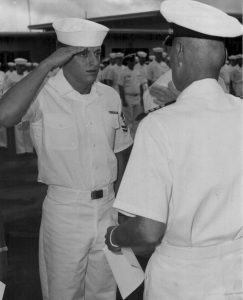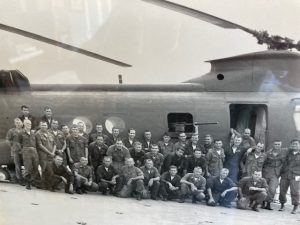Virtual Museum: Vietnam War
Heroes Hall Virtual Museum is a place where residents from Orange County and surrounding areas can share photos of veterans and military memorabilia that holds meaning for them.
Those Who Served in Vietnam War
This section tells the stories of local veterans who served in the Vietnam War. Veterans are listed in alphabetical order by last name.
David Martinez
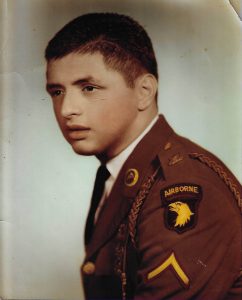
David Martinez was born and raised in La Habra. He played football on the Fullerton Junior College Football Team and shortly after the team won the Junior Rose Bowl Game in 1965, he enlisted in the U.S. Army. He joined the service under the buddy system along with three of his friends with the intention of serving in Vietnam. He joined the 101st Airborne Division (paratroopers) and was trained as a medic. From 1967 to 1968 he served as a reconnaissance medic in Vietnam. During the war, it was not uncommon for Martinez to have so many severely injured patients to care for at one time that he ran out of medical supplies. For his combat service, Martinez earned the Silver Star, Bronze Medal with a V, Soldier’s Medal (valor), Air Medal, Combat Medical Badge and Parachute Badge.
After his military service, he attended Cal State Fullerton and was employed with the local health department as an emergency medical specialist. He also performed social work for migrant workers in need of medical care in Orange County. Martinez is retired and lives with his wife Emily in La Habra. He has one daughter and three stepdaughters.
Conrad Neumann
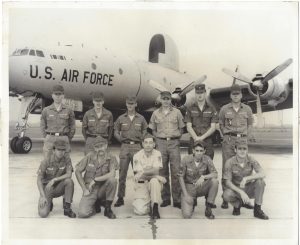
Conrad Neumann was born April 29, 1945. He served in the U.S. Air Force from June 1963 to June 1971 as an airborne radar maintenance repairman. He was assigned to the 552nd AEW&C Wing, ADC, McClellan AFB, in Sacramento. During the Vietnam War, he was deployed to Korat, Thailand, in support of the Big Eye and College Eye Task Forces, where he was responsible for maintaining the radar equipment aboard the EC-121D/T Warning Star. In Southeast Asia, these unarmed radar aircraft aided in downing enemy planes, directed U.S. aircraft to aerial refueling tankers, and guided rescue planes to downed pilots. One such aircraft on display at the National Museum of the Air Force was nicknamed Triple Nickel because of its serial number (53-555). On Oct. 24, 1967, over the Gulf of Tonkin, it guided a U.S. fighter into position to destroy a MiG-21. This action marked the first time a weapons controller aboard an airborne radar aircraft had ever directed a successful attack on an enemy plane.
Neumann left the Air Force in June 1971, and in 1973 he enlisted in the California Air National Guard and served as a radio maintenance technician until 1991. When he retired from the National Guard, he worked for a local telephone manufacturing company until 2002. He currently resides in Huntington Beach.
Donald W. Pageler
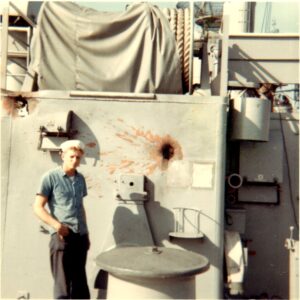
Donald W. Pageler was born in Wamego, Kansas, on Feb. 1, 1946. He joined the U.S. Navy in June 1966 and was trained as a communications technician in Pensacola, Florida. After his training, he was assigned to the USS Liberty, a converted World War II transport ship. On June 8, 1967, while on a mission in the Eastern Mediterranean, 15 miles from the shore off the Gaza Strip, the ship was attacked by the Israeli Air Force and Navy. The unprovoked attack by an allied nation killed 34 U.S. sailors and wounded 174. Pageler was on the mess deck at the time of the initial attack and immediately went to the bridge to help transport the injured to safety. While trying to save his fellow sailors, Pageler was also injured. Despite the devastating attack, which included damage from machine guns, torpedoes, cannons and napalm, the USS Liberty was able to sail 1,000 miles to Malta, where the injured and the dead were transported ashore and the ship underwent repairs. It was later discovered that top U.S. officials called off rescue efforts to help the crew of the Liberty because they did not want to embarrass a U.S. ally. The Israeli government stated that the attack was simply a case of mistaken identity. After returning to the U.S., Pageler was told to never speak about the incident to anyone.
As a result of his experience, Pageler suffered from health problems as well as post-traumatic stress. He has spent his life trying to raise awareness about the attack on the USS Liberty and the government’s attempt to cover up the incident. After leaving the Navy in March 1970 as an E-5, Pageler returned to Kansas, where he earned a bachelor’s degree in business administration at the University of Kansas. After a long career with Boeing, Pageler is now retired and lives in Westminster. His wife Eva passed away on May 30, 2012.
William “Bill” Ring

William “Bill” Ring was born in December 1945 in Chicago, Illinois. He joined the Marine Corps in April 1966 and became a naval aviator. He served in active duty until June 1970 and then joined the active reserves until 1972. His first duty station was MCAS Tustin, where he transitioned to flying H-46 helicopters. He was then deployed to Vietnam for a 13-month tour at Phu Bai, where he flew combat missions with HMM -364, The Purple Foxes; and HMM-165, The White Knights. He also served aboard the USS Tripoli, off the coast of South Vietnam. He flew missions supporting the Marines at Khe Sahn and Hue City during the Tet Offensive in 1968. After returning to the states, he became the Assistant Wing Aviation Safety Officer at El Toro flying the A-4 Skyhawk, H-46, H-53 and OV-10. He then joined his final squadron at Tustin with HMM-163 Ridge Runners as an H-46 squadron pilot. He continued to fly as a squadron pilot and squadron test pilot with the reserves at Los Alamitos and Tustin, attaining the rank of captain while finishing his college degree at Cal State Long Beach.
During his career in the Marine Corps, Ring was awarded the following: the Distinguished Flying Cross, Purple Heart, Air Medal (26) 529 combat missions, Presidential Unit Citation, Combat Action Ribbon, and the Vietnamese Cross of Gallantry. After leaving the military, Ring pursued various careers including conducting operations for Lion Country Safari in Irvine, working as a real estate broker, bartender, a ski bum, and tuna boat helicopter pilot. He is currently an investment adviser and has been in the profession for 37 years. He lives in Mission Viejo with his wife of 33 years, Pam.
Dennis Stotts
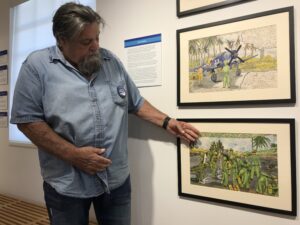
Dennis James Stotts (Deny) was born Dec. 27, 1948, in Holly, Michigan. Stotts graduated from high school in 1966, in the midst of the Vietnam War, when the nation was still implementing a national draft for the armed forces. Stotts chose to volunteer instead of being drafted for the U.S. Marine Corps due to their “First to Fight” disposition. In the summer of 1966, Stotts was inducted into the Marine Corps in San Diego. He completed his infantry training at Camp Pendleton and artillery training at Los Pulgas, where he was assigned to Fox Battery, Second Battalion, 11th Marines, First Marine Division.
In 1967, Stotts was sent to South Vietnam where he served a 13-month in-country tour of duty. Stotts was assigned as a Fire Direction Controller for a 105mm Howitzer battery. These artillerymen were the lifeline for many beleaguered Marines who were cut off or actively being assaulted by the enemy.
His first assignment was near the summit of the Hải Vân Pass, a mountainous choke point along the Vietnamese coast, which topographically separated North and South Vietnam. This area was a “hot zone,” which saw constant incursions by the Viet Cong, a pro-Hanoi South Vietnamese based insurgency organization. In January 1968, the North Vietnamese Army, along with the Viet Cong, launched an offensive that capitalized on the National Holiday of Tet, which had always been considered a time for a de-facto cease fire between the North and South. Suddenly, without warning, Americans, South Koreans, Australians, and South Vietnamese ARVN (Army of the Republic of Vietnam), were assaulted by enemy soldiers. Over the next few months, Stotts would find himself directing artillery fire in support of his fellow Marines, including during the assault on Hue City.
His active service came to an end in 1970, but this was not to be the end of Stotts’ service story. Ten years later, after returning from Australia, Stotts felt a sense of duty to reenlist. He served another eight years as a Battalion Survey Chief, until he was honorably discharged in 1988.
Service Medals/Citations
Expert Rifle/Pistol
Letter of Commendation
Meritorious Unit Commendation
Good Conduct Medal
National Defense Service Medal
Combat Action Ribbon
Meritorious Mast Outstanding Performance
Stott is now retired after 20 years of service with the City of San Clemente in the Waste Water Management Department. He lives with his daughter in San Juan Capistrano.
Anthony John Trasport, Jr.
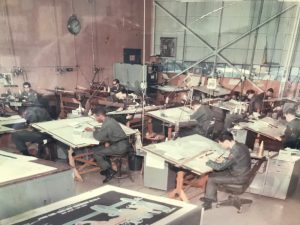
Anthony John Trasport, Jr. was born Dec 21, 1938, in Pittsburgh, Pennsylvania. Prior to his military service, he attended Cleveland Institute of Art and earned a degree in fine arts. In 1963 he was drafted into the U.S. Army and stationed at Aberdeen Proving Grounds in Havre de Grace, Maryland. He was originally ordered to deploy to Vietnam as a missile loader, but when the company commander learned that he had a degree in art, he was reassigned to the art department. As an army illustrator, he created diagrams for military drills and war games, as well as drafted invitations, announcements and correspondence for officers. He also painted a portrait of an officer who was killed in the war; he received an award for the painting.
After separating from the military, Trasport settled with his family in Fullerton and started a career in the restaurant business while doing freelance art work on the side. He started his own restaurant called Huckleberry’s Famous Sandwiches, which had three locations in Orange County. In 1984 he sold the restaurants and became a full-time painter. He set up an art studio in his home, where he and his wife Judith created art murals and projects for businesses throughout the country. Trasport and his wife Judith had two daughters. He passed away on Nov. 2, 2014.
Uniforms & Medals
Photos below were submitted by veterans featured above. This gallery includes photos of uniforms, medals and other recognition these veterans of the Vietnam War received. (Click thumbnail to view)
On the Battle Ground
Photos below were submitted by veterans featured above. This gallery includes photos taken during the Vietnam War, on location.

